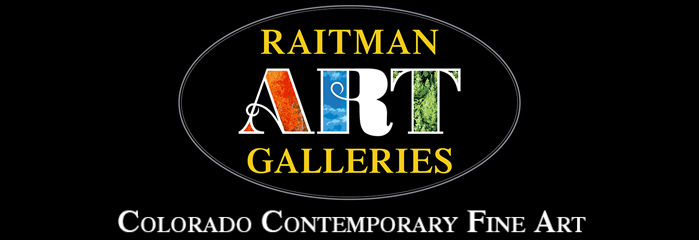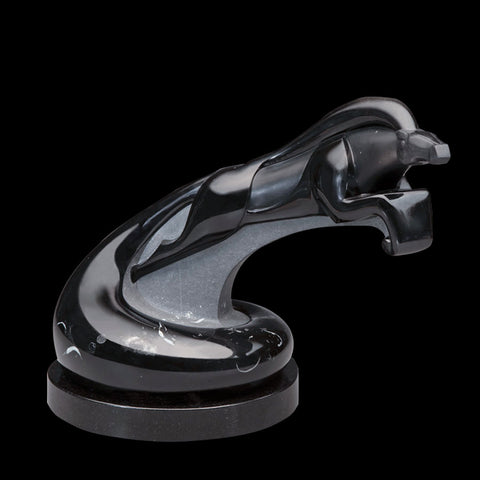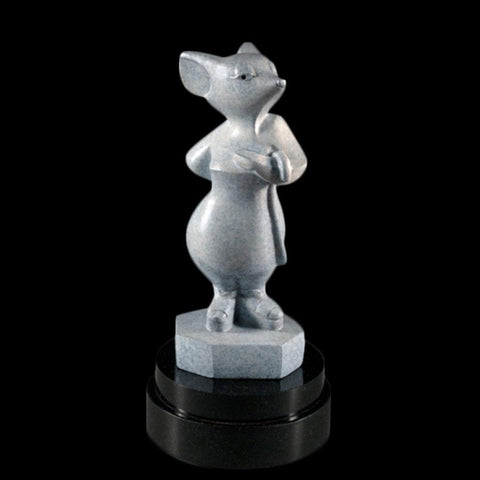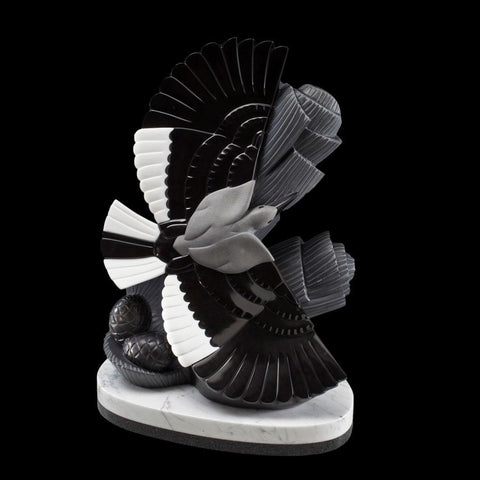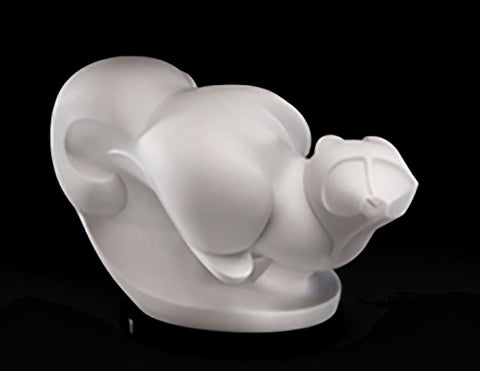Squash and Stretch
Please Call for Pricing
This piece is made of Sivec Marble, Mongolian Imperial Black Marble on a Carrara Marble and Granite base. It measures 19 x 18 1/2 x 12 1/2 inches.
From Ellen:
I love the variety of shapes assumed by birds with lots of fluffy feathers, such as these two white-tailed ptarmigans. They are fun to look at and fun to draw. The details of anatomy disappear when using simple, streamlined shapes, and design becomes the captivating element.
Squash and stretch is one of the most important ingredients in traditional Disney animation. It is defined as change in shape with no change in volume, as illustrated by the poses of these ptarmigans. The principle of Squash and Stretch gives character animation life, weight, and flexibility, and makes Disney animation fun to watch and fun to create. It can be as subtle as the squash in a monkey’s cheek as he snuggles into his pillow to sleep, or as broad as the extreme stretch in anticipation as he raises a fruit bowl to klonk a loud-mouthed parrot on the head. (I had the pleasure of animating both of these scenes in “Aladdin” during my long tenure at Disney.)
Ptarmigans are members of the grouse family and live above the tree line in the alpine zone–rocky areas, meadows, snow fields, and krumholz (defined as “stunted and deformed vegetation caused by continual exposure to fierce, freezing winds”–I love that description!) Ptarmigans have some terrific adaptations to life in a harsh environment: black eyes that filter ultraviolet rays; thick feathers around their nostrils to warm frigid air before they breathe it; dense, fluffy feathers on their feet and legs for warmth and for ease in walking on snow; they burrow in the snow up to their necks to keep warm, elude predators, and endure blizzards; they stay still for long periods of time to conserve energy and will remain motionless, rather than flying, when approached.
Brian and I set out on a lovely day in mid-September, 2012, in search of ptarmigans. We took the little green Sidekick and drove up to the Continental Divide. At a great Visitors Center there, we asked the rangers for information on ptarmigans. We were in luck–a flock had been seen nearby just the day before. (The rangers are terrific!) We hiked out a narrow trail on Medicine Bow Curve and found 6 ptarmigans near a small pond. They were already in the process of changing from their speckled summer feathers to pure white winter feathers–white bottoms with speckled tops. The zoom on the camera was not powerful enough to photograph them, but the binoculars were much more powerful, so we stood there on top of the world (so it felt) observing. The weather changes quickly at 13,000 feet and it started to rain, then the wind came up and the temperature fell, the rain froze and fell harder stinging our hands and faces, and then turned to snow. We stood there watching the ptarmigans as long as we could. They were resting, preening, pecking and eating, squabbling, spending a lovely day. We took turns with the binos, and, even with frequent trade-offs so we could stuff our hands in our pockets for a bit of warmth, we could only last about 45 minutes . . . yes, we are that wimpy. We retreated to our tiny car, and crept down the slippery, winding road (with unreliable traction) exclaiming all the way at our good fortune in finding ptarmigans in the vast loneliness of the alpine tundra, and our first blizzard of the season.
The stone is Sivec (sa-VETCH) Marble from Greece, the same stone from which the ancient Greeks made their temples, plazas, and statues. The marble is pristine and gorgeous, the crystal is of medium size with a brilliant sparkle. Soft curves and crisp edges are a tandem theme along with changes in shape in “Squash and Stretch,” where light plays over the surfaces to gently reveal the variety of forms. Carving white marble is an adventure of discovery, not unlike our trip in search of ptarmigans.
